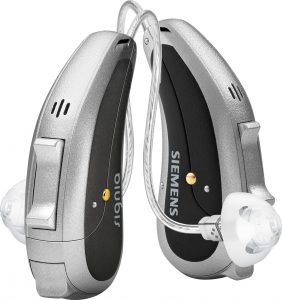Moisture
 You should keep your hearing aids as dry and free of humidity as possible. Hearing aids are exposed to 100% humidity inside your ear. In addition, you may be tempted to clean the aids with water or some type of fluid cleaner — DON’T. Wiping the outside of the aid is sufficient.
You should keep your hearing aids as dry and free of humidity as possible. Hearing aids are exposed to 100% humidity inside your ear. In addition, you may be tempted to clean the aids with water or some type of fluid cleaner — DON’T. Wiping the outside of the aid is sufficient.
To reduce moisture build-up in the aids, you can place them in a silica gel container. We call this a DRI-AID kit. The substance in the jar of the kit is a drying agent and will draw excess humidity from the aids to reduce the chances of corrosion and failure from moisture.
Wiping
If you feel that you would like to wipe the outer surface of the aids with something to remove some of the skin and hair oil from them, you can use a damp tissue for this. Just moisten two fingers with water, shake off the excess, and then dry them with the tissue. This is the most water you should use on your hearing aids; a just barely dampened tissue. It will serve to freshen the surfaces of the aid by keeping them free from skin oils and dust.
Brushing
 The tip of the hearing aid (or the separate earmold, if you are using a behind-the-ear style aid) often picks up excess earwax, oils and dust from being inserted into the ear. This wax is scooped up and can become excessive on the tip of the earpiece. If enough accumulates over the receiver (sound source) of the aid, it will not emit any sound. The aid will appear to have stopped working altogether.
The tip of the hearing aid (or the separate earmold, if you are using a behind-the-ear style aid) often picks up excess earwax, oils and dust from being inserted into the ear. This wax is scooped up and can become excessive on the tip of the earpiece. If enough accumulates over the receiver (sound source) of the aid, it will not emit any sound. The aid will appear to have stopped working altogether.
Using the brush you received with your aid, gently brush the tip of your aid(s) in an upward motion drawing the wax away from the tip as one would do in “whittling” the tip to a point. This motion will free the small deposits of wax from the surface of the aid and open the sound port so you can hear with it again.
Brushing is the user’s responsibility. Your audiologist will assist you by doing a more thorough cleaning of the inside of the aid when he sees you for your periodic check-ups. Between these professional visits, you must brush your aid every day to remove even small amounts of earwax before they can build up into layers and clog the sound going into your ears.
Earwax in Your Ears
If you are someone who develops a physical blockage in your ear canals from earwax, you may need to have this removed periodically. Your primary physician is a good source for this treatment or he may wish to have this done by a specialist (an ear, nose and throat specialist or an audiologist) if your ears are unusually shaped or sensitive to treatment. Attempting to clean them yourself is not a good idea. You cannot see how you are progressing so you are more likely to push the earwax further in or do physical damage to your ear. Always let a specialist remove your earwax.

